Features of Temporal Variability of the Concentrations of Gaseous Trace Pollutants in the Air of the Urban and Rural Areas in the Southern Baikal Region (East Siberia, Russia)
Abstract
:1. Introduction
2. Sampling and Analysis Methods
3. Results and Discussion
3.1. Seasonal Variability of Gaseous Pollutants under Urban and Rural Conditions
3.2. Weekly and Daily Variations of SO2, NO, and NO2
4. Dependence of Air Pollution at the Listvyanka Station on Meteorological Parameters
5. Conclusions
Author Contributions
Funding
Institutional Review Board Statement
Informed Consent Statement
Data Availability Statement
Conflicts of Interest
References
- Sheng, J.X.; Weisenstein, D.K.; Luo, B.P.; Rozanov, E.; Stenke, A.; Anet, J.; Peter, T. Global atmospheric sulfur budget under volcanically quiescent conditions: Aerosol-chemistry-climate model predictions and validation. J. Geophys. Res. Atmos. 2015, 120, 256–276. [Google Scholar] [CrossRef]
- Porter, J.G.; De Bruyn, W.; Saltzman, E.S. Eddy flux measurements of sulfur dioxide deposition to the sea surface. Atmos. Chem. Phys. 2018, 18, 15291–15305. [Google Scholar] [CrossRef]
- Kamarehie, B.; Ghaderpoori, M.; Jafari, A.; Karami, M.; Mohammadi, A.; Azarshab, K.; Noorizadeh, N. Quantification of health effects related to SO2 and NO2 pollutants by using air quality model. J. Adv. Environ. Health Res. 2017, 5, 44–50. [Google Scholar] [CrossRef]
- World Health Organization. WHO Global Air Quality Guidelines: Particulate Matter (PM2.5 and PM10), Ozone, Nitrogen Dioxide, Sulfur Dioxide and Carbon Monoxide; World Health Organization: Geneva, Switzerland, 2021. [Google Scholar]
- Manisalidis, I.; Stavropoulou, E.; Stavropoulos, A.; Bezirtzoglou, E. Environmental and health impacts of air pollution: A review. Front. Public Health 2020, 8, 14. [Google Scholar] [CrossRef]
- Vinken, G.C.M.; Boersma, K.F.; Maasakkers, J.D.; Adon, M.; Martin, R.V. Worldwide biogenic soil NOx emissions inferred from OMI NO2 observations. Atmos. Chem. Phys. 2014, 14, 10363–10381. [Google Scholar] [CrossRef]
- Erickson, L.E.; Newmark, G.L.; Higgins, M.J.; Wang, Z. Nitrogen oxides and ozone in urban air: A review of 50 plus years of progress. Environ. Prog. Sustain. Energy 2020, 39, e13484. [Google Scholar] [CrossRef]
- Dix, B.; de Bruin, J.; Roosenbrand, E.; Vlemmix, T.; Francoeur, C.; Gorchov-Negron, A.; McDonald, B.; Zhizhin, M.; Elvidge, C.; Veefkind, P.; et al. Nitrogen oxide emissions from US oil and gas production: Recent trends and source attribution. Geophys. Res. Lett. 2020, 47, e2019GL085866. [Google Scholar] [CrossRef]
- Schumann, U.; Huntrieser, H. The global lightning-induced nitrogen oxides source. Atmos. Chem. Phys. 2007, 7, 3823–3907. [Google Scholar] [CrossRef]
- Song, W.; Wang, Y.L.; Yang, W.; Sun, X.C.; Tong, Y.D.; Wang, X.M.; Liu, C.Q.; Bai, Z.P.; Liu, X.Y. Isotopic evaluation on relative contributions of major NOx sources to nitrate of PM2.5 in Beijing. Environ. Pollut. 2019, 248, 183–190. [Google Scholar] [CrossRef]
- Song, W.; Hu, C.C.; Chen, G.Y.; Liu, X.J.; Walters, W.W.; Michalski, G.; Liu, C.Q. Important contributions of non-fossil fuel nitrogen oxides emissions. Nat. Commun. 2021, 12, 243. [Google Scholar] [CrossRef]
- Galloway, J.N.; Leach, A.M.; Bleeker, A.; Erisman, J.W. A chronology of human understanding of the nitrogen cycle. Philos. Trans. R. Soc. B Biol. Sci. 2013, 368, 20130120. [Google Scholar] [CrossRef] [PubMed]
- Valin, L.C.; Russell, A.R.; Cohen, R.C. Variations of OH radical in an urban plume inferred from NO2 column measurements. Geophys. Res. Lett. 2013, 40, 1856–1860. [Google Scholar] [CrossRef]
- Duncan, B.N.; Yoshida, Y.; Olson, J.R.; Sillman, S.; Martin, R.V.; Lamsal, L.; Hu, Y.; Pickering, K.E.; Retscher, C.; Allen, D.J.; et al. Application of OMI observations to a space-based indicator of NOx and VOC controls on surface ozone formation. Atmos. Environ. 2010, 44, 2213–2223. [Google Scholar] [CrossRef]
- Ryan, R.G.; Rhodes, S.; Tully, M.; Schofield, R. Surface ozone exceedances in Melbourne, Australia are shown to be under NOx control, as demonstrated using formaldehyde: NO2 and glyoxal: Formaldehyde ratios. Nat. Commun. 2020, 749, 141460. [Google Scholar] [CrossRef]
- Jion, M.M.M.F.; Jannat, J.N.; Mia, Y.; Ali, A.; Islam, S.; Ibrahim, S.M.; Pal, S.C.; Islam, A.; Sarker, A.; Malafaia, G.; et al. A critical review and prospect of NO2 and SO2 pollution over Asia: Hotspots, trends, and sources. Sci. Total Environ. 2023, 876, 162851. [Google Scholar] [CrossRef] [PubMed]
- Wang, Y.; Ali, A.; Bilal, M.; Qiu, Z.; Mhawish, A.; Almazroui, M.; Shahid, S.; Islam, M.N.; Zhang, Y.; Haque, N. Identification of NO2 and SO2 pollution hotspots and sources in Jiangsu Province of China. Remote Sens. 2021, 13, 3742. [Google Scholar] [CrossRef]
- Ye, C.; Lu, K.; Song, H.; Mu, Y.; Chen, J.; Zhang, Y. A critical review of sulfate aerosol formation mechanisms during winter polluted periods. J. Environ. Sci. 2023, 123, 387–399. [Google Scholar] [CrossRef]
- Wang, J.; Li, J.; Ye, J.; Zhao, J.; Wu, Y.; Hu, J.; Jacob, D.J. Fast sulfate formation from oxidation of SO2 by NO2 and HONO observed in Beijing haze. Nat. Commun. 2020, 11, 2844. [Google Scholar] [CrossRef] [PubMed]
- Borhani, F.; Shafiepour Motlagh, M.; Rashidi, Y.; Ehsani, A.H. Estimation of short-lived climate forced sulfur dioxide in Tehran, Iran, using machine learning analysis. Stoch. Environ. Res. Risk Assess. 2022, 36, 2847–2860. [Google Scholar] [CrossRef]
- Adame, J.A.; Lope, L.; Sorribas, M.; Notario, A.; Yela, M. SO2 measurements in a clean coastal environment of the southwestern Europe: Sources, transport and influence in the formation of secondary aerosols. Sci. Total Environ. 2020, 716, 137075. [Google Scholar] [CrossRef]
- Liu, Y.; Zheng, M.; Yu, M.; Cai, X.; Du, H.; Li, J.; He, K. High-time-resolution source apportionment of PM2.5 in Beijing with multiple models. Atmos. Chem. Phys. 2019, 19, 6595–6609. [Google Scholar] [CrossRef]
- Wang, H.; Li, J.; Gao, Z.; Yim, S.H.; Shen, H.; Ho, H.C.; Li, Z.; Zeng, Z.; Liu, C.; Li, Y.; et al. High-spatial-resolution population exposure to PM2.5 pollution based on multi-satellite retrievals: A case study of seasonal variation in the Yangtze River Delta, China in 2013. Remote Sens. 2019, 11, 2724. [Google Scholar] [CrossRef]
- Tiotiu, A.I.; Novakova, P.; Nedeva, D.; Chong-Neto, H.J.; Novakova, S.; Steiropoulos, P.; Kowal, K. Impact of air pollution on asthma outcomes. Int. J. Environ. Res. Public Health 2020, 17, 6212. [Google Scholar] [CrossRef] [PubMed]
- Kovadlo, P.; Shikhovtsev, A.; Lukin, V.; Kochugova, E. Solar activity variations inducing effects of light scattering and refraction in the Earth’s atmosphere. J. Atmos. Sol.-Terr. Phys. 2018, 179, 468–471. [Google Scholar] [CrossRef]
- Zeng, Z.; Gui, K.; Wang, Z.; Luo, M.; Geng, H.; Ge, E.; An, J.; Song, X.; Ning, G.; Zhai, S.; et al. Estimating hourly surface PM2.5 concentrations across China from high-density meteorological observations by machine learning. Atmos. Res. 2021, 254, 105516. [Google Scholar] [CrossRef]
- Gharibzadeh, M.; Bidokhti, A.A.; Alam, K. The interaction of ozone and aerosol in a semi-arid region in the Middle East: Ozone formation and radiative forcing implications. Atmos. Environ. 2021, 245, 118015. [Google Scholar] [CrossRef]
- Liu, J.; Guo, Z.; Zhou, L.; Wang, L.; Wang, J.; Yan, Q.; Hua, D. Inversion and analysis of aerosol optical properties and lidar ratios based on sky-radiometer and Raman lidar measurements in Xi’an, China. Front. Environ. Sci. 2022, 10, 1039559. [Google Scholar] [CrossRef]
- Greenberg, N.; Carel, R.S.; Derazne, E.; Bibi, H.; Shpriz, M.; Tzur, D.; Portnov, B.A. Different effects of long-term exposures to SO2 and NO2 air pollutants on asthma severity in young adults. J. Toxicol. Environ. Health Part A 2016, 79, 342–351. [Google Scholar] [CrossRef]
- Zheng, X.Y.; Orellano, P.; Lin, H.L.; Jiang, M.; Guan, W.J. Short-term exposure to ozone, nitrogen dioxide, and sulphur dioxide and emergency department visits and hospital admissions due to asthma: A systematic review and meta-analysis. Environ. Int. 2021, 150, 106435. [Google Scholar] [CrossRef]
- Chiang, T.Y.; Yuan, T.H.; Shie, R.H.; Chen, C.F.; Chan, C. Increased incidence of allergic rhinitis, bronchitis and asthma, in children living near a petrochemical complex with SO2 pollution. Environ. Int. 2016, 96, 1–7. [Google Scholar] [CrossRef]
- Dehghani, M.; Keshtgar, L.; Javaheri, M.R.; Derakhshan, Z.; Oliveri Conti, G.; Zuccarello, P.; Ferrante, M. The effects of air pollutants on the mortality rate of lung cancer and leukemia. Mol. Med. Rep. 2017, 15, 3390–3397. [Google Scholar] [CrossRef] [PubMed]
- Gawełko, J.; Cierpiał-Wolan, M.; Bwanakare, S.; Czarnota, M. Association between Air Pollution and Squamous Cell Lung Cancer in South-Eastern Poland. Int. J. Environ. Res. Public Health 2022, 19, 11598. [Google Scholar] [CrossRef] [PubMed]
- Sebald, V.; Goss, A.; Ramm, E.; Gerasimova, J.V.; Werth, S. NO2 air pollution drives species composition, but tree traits drive species diversity of urban epiphytic lichen communities. Environ. Pollut. 2022, 308, 119678. [Google Scholar] [CrossRef] [PubMed]
- Saneev, B.G.; Ivanova, I.Y.; Maysyuk, E.P.; Tuguzova, T.F.; Ivanov, R.A. The energy infrastructure of the central ecological zone: Air in the natural environment and its ways of removal. Geogr. Nat. Resour. 2016, 5, 218–224. (In Russian) [Google Scholar]
- The State Report “On the State and Environmental Protection of the Irkutsk Region in 2019; Megaprint: Irkutsk, Russia, 2020; 314p. (In Russian)
- Khodzher, T.V.; Yausheva, E.P.; Shikhovtsev, M.Y.; Zhamsueva, G.S.; Zayakhanov, A.S.; Golobokova, L.P. Black Carbon in the Air of the Baikal Region, (Russia): Sources and Spatiotemporal Variations. Appl. Sci. 2024, 14, 6996. [Google Scholar] [CrossRef]
- Obolkin, V.A.; Potemkin, V.L.; Makukhin, V.L.; Khodzher, T.V.; Chipanina, E.V. Long-Range Transport of Plumes of Atmospheric Emissions from Regional Coal Power Plants to the South Baikal Water Basin. Atmos. Ocean. Opt. 2017, 30, 360–365. [Google Scholar] [CrossRef]
- Obolkin, V.A.; Potemkin, V.L.; Makukhin, V.L.; Chipanina, E.V.; Marinaite, I.I. Peculiarities of spatial distribution of sulfur dioxide in Cisbaikalia from the data of shipboard measurements and numerical experiments. Russ. Meteorol. Hydrol. 2014, 39, 809–813. [Google Scholar] [CrossRef]
- Molozhnikova, E.V.; Golobokova, L.P.; Marinaite, I.I.; Netsvetaeva, O.G.; Shekhovtsev, M.Y.; Khodzher, T.V. Chemical Compound of Atmospheric Deposition in the Baikal State Biospherical Nature Reserve (the Eastern Coast of Southern Baikal). Russ. Meteorol. Hydrol. 2023, 48, 291–299. [Google Scholar] [CrossRef]
- Ivanova, I.Y.; Ivanov, R.A. Use of Geovisualization in the Analysis of the Placement of Energy Infrastructure Facilities in the Central Ecological Zone of the Baikal Natural Territory. Informatsionnyye Mat. Tekhnologii Nauk. Upr. [Inf. Math. Technol. Sci. Manag.] 2016, № 4-2, 80–89. (In Russian) [Google Scholar]
- Baldauf, R.W.; Watkins, N.; Heist, D.; Bailey, C.; Rowley, P.; Shores, R. Near road air quality monitoring: Factors affecting network design and interpretation of data. Air Qual. Atmos. Health 2009, 2, 1–9. [Google Scholar] [CrossRef]
- Molozhnikova, E.V. Uchet zagryazneniya okruzhayushchey sredy aerozolyami v zadachakh razvitiya energeticheskikh sistem [Monitoring of Environmental Pollution by Aerosols in Energy Systems Development]. Ph.D. Thesis, Melentyev Energy Systems Institute of the Siberian Branch of the Russian Academy of Sciences, Irkutsk, Russia, 2003. (In Russian). [Google Scholar]
- Maisyuk, E.P. The Role of Energy in the Ecological State of the Baikal Natural Territory. Geogr. Nat. Resour. 2017, 100–107. (In Russian) [Google Scholar] [CrossRef]
- Molozhnikova, Y.V.; Shikhovtsev, M.Y.; Netsvetaeva, O.G.; Khodzher, T.V. Ecological Zoning of the Baikal Basin Based on the Results of Chemical Analysis of the Composition of Atmospheric Precipitation Accumulated in the Snow Cover. Appl. Sci. 2023, 13, 8171. [Google Scholar] [CrossRef]
- Obolkin, V.A.; Shamanskii, Y.u.V.; Khodzher, T.V.; Falits, A.V. Mesoscale Processes of Atmospheric Pollutants Transfer in the South Baikal Region. Okeanol. Issled. [J. Oceanol. Res.] 2019, 47, 104–113. [Google Scholar] [CrossRef] [PubMed]
- Khuriganova, O.I.; Obolkin, V.A.; Golobokova, L.P.; Khodzher, T.V. Monitoring of Atmospheric Trace Gases in Urban and Rural Areas of the Baikal Natural Territory during 2019–2021. Russ. Meteorol. Hydrol. 2023, 48, 324–333. [Google Scholar] [CrossRef]
- Spicer, C.W.; Kenny, D.V.; Ward, G.F.; Billick, I.H. Transformations, lifetimes, and sources of NO2, HONO, and HNO3 in indoor environments. Air Waste 1993, 43, 1479–1485. [Google Scholar] [CrossRef]
- Ye, C.; Zhou, X.; Pu, D.; Stutz, J.; Festa, J.; Spolaor, M.; Tsai, C.; Cantrell, C.; Mauldin, R.L.; Campos, T.; et al. Rapid cycling of reactive nitrogen in the marine boundary layer. Nature 2016, 532, 489–491. [Google Scholar] [CrossRef]
- Potemkina, T.; Potemkin, V. Extreme phenomena in the Lake Baikal basin: Tropical nights and hot days as indicators of climate warming (Eastern Siberia, Russia). Theor. Appl. Climatol. 2024, 155, 6581–6590. [Google Scholar] [CrossRef]
- Guo, L.C.; Zhang, Y.; Lin, H.; Zeng, W.; Liu, T.; Xiao, J.; Ma, W. The washout effects of rainfall on atmospheric particulate pollution in two Chinese cities. Environ. Pollut. 2016, 215, 195–202. [Google Scholar] [CrossRef]
- Yoo, J.M.; Lee, Y.R.; Kim, D.; Jeong, M.J.; Stockwell, W.R.; Kundu, P.K.; Lee, S.J. New indices for wet scavenging of air pollutants (O3, CO, NO2, SO2, and PM10) by summertime rain. Atmos. Environ. 2014, 82, 226–237. [Google Scholar] [CrossRef]
- Duhanyan, N.; Roustan, Y. Below-cloud scavenging by rain of atmospheric gases and particulates. Atmos. Environ. 2011, 45, 7201–7217. [Google Scholar] [CrossRef]
- Shikhovtsev, A.Y. Reference optical turbulence characteristics at the Large Solar Vacuum Telescope site. Publ. Astron. Soc. Jpn. 2024, 31, 538–549. [Google Scholar] [CrossRef]
- Kotthaus, S.; Halios, C.H.; Barlow, J.F.; Grimmond, C.S.B. Volume for pollution dispersion: London’s atmospheric boundary layer during ClearfLo observed with two ground-based lidar types. Atmos. Environ. 2018, 190, 401–414. [Google Scholar] [CrossRef]
- Seibert, P.; Beyrich, F.; Gryning, S.E.; Joffre, S.; Rasmussen, A.; Tercier, P. Review and intercomparison of operational methods for the determination of the mixing height. Atmos. Environ. 2000, 34, 1001–1027. [Google Scholar] [CrossRef]
- Wang, J.; Alli, A.S.; Clark, S.; Hughes, A.; Ezzati, M.; Beddows, A.; Vallarino, J.; Nimo, J.; Bedford-Moses, J.; Baah, S.; et al. Nitrogen oxides (NO and NO2) pollution in the Accra metropolis: Spatiotemporal patterns and the role of meteorology. Sci. Total Environ. 2022, 803, 149931. [Google Scholar] [CrossRef] [PubMed]
- Bolbasova, L.A.; Shikhovtsev, A.Y.; Kopylov, E.A.; Selin, A.A.; Lukin, V.P.; Kovadlo, P.G. Daytime optical turbulence and wind speed distributions at the Baikal Astrophysical Observatory. Mon. Not. R. Astron. Soc. 2019, 482, 2619–2626. [Google Scholar] [CrossRef]
- Shikhovtsev, M.Y.; Molozhnikova, Y. Inter-annual dynamics of regional and transboundary transport of air masses of the Baikal region for 2010–2018. Proc. SPIE 2020, 11560, 1–8. [Google Scholar] [CrossRef]
- Shikhovtsev, M.Y.; Obolkin, V.A.; Khodzher, T.V.; Molozhnikova, Y.V. Variability of the Ground Concentration of Particulate Matter PM1-PM10 in the Air Basin of the Southern Baikal Region. Atmos. Ocean. Opt. 2023, 36, 655–662. [Google Scholar] [CrossRef]
- Bahino, J.; Yoboué, V.; Galy-Lacaux, C.; Adon, M.; Akpo, A.; Keita, S.; Liousse, C.; Gardrat, E.; Chiron, C.; Ossohou, M.; et al. A pilot study of gaseous pollutants’ measurement (NO2, SO2, NH3, HNO3 and O3) in Abidjan, Côte d’Ivoire: Contribution to an overview of gaseous pollution in African cities. Atmos. Chem. Phys. 2018, 18, 5173–5198. [Google Scholar] [CrossRef]
- Novikova, S.A. Pollution of Atmosphere by Auto Transport Emissions in Big Cities of Irkutsk Region. Bull. Irkutsk. State Univ. Ser. «Earth Sci.» 2015, 11, 64–82. (In Russian) [Google Scholar]
- Sokolova, N.A.; Chelpanova, I.A.; Levashev, A.G. Study of Parameters of Transport Flow and Visitors of the Tourist Listvyanka Settlement in the Irkutsk Region. Mezhdunarodnyy Zhurnal Gumanit. Yestestvennykh Nauk. [Int. J. Humanit. Nat. Sci.] 2022, 230–234. (In Russian) [Google Scholar] [CrossRef]
- Obolkin, V.; Molozhnikova, E.; Shikhovtsev, M.; Netsvetaeva, O.; Khodzher, T. Sulfur and nitrogen oxides in the atmosphere of lake baikal: Sources, automatic monitoring, and environmental risks. Atmosphere 2021, 12, 1348. [Google Scholar] [CrossRef]
- Gubanova, D.P.; Belikov, I.B.; Elansky, N.F.; Skorokhod, A.I.; Chubarova, N.E. Variations in PM2.5 Surface Concentration in Moscow according to Observations at MSU Meteorological Observatory. Atmos. Ocean. Opt. 2018, 31, 290–299. [Google Scholar] [CrossRef]
- Soleimanpour, M.; Alizadeh, O.; Sabetghadam, S. Analysis of diurnal to seasonal variations and trends in air pollution potential in an urban area. Sci. Rep. 2023, 13, 21065. [Google Scholar] [CrossRef] [PubMed]
- Ionov, D.V.; Poberovskii, A.V. Variability of Nitrogen Oxides in the Atmospheric Surface Layer near Saint Petersburg. Russ. Meteorol. Hydrol. 2020, 45, 720–726. [Google Scholar] [CrossRef]
- Jang, E.; Do, W.; Park, G.; Kim, M.; Yoo, E. Spatial and temporal variation of urban air pollutants and their concentrations in relation to meteorological conditions at four sites in Busan, South Korea. Atmos. Pollut. Res. 2017, 8, 89–100. [Google Scholar] [CrossRef]
- Kendrick, C.M.; Koonce, P.; George, L.A. Diurnal and seasonal variations of NO, NO2 and PM2.5 mass as a function of traffic volumes alongside an urban arterial. Atmos. Environ. 2015, 122, 133–141. [Google Scholar] [CrossRef]
- Henry, R.; Norris, G.A.; Vedantham, R.; Turner, J.R. Source region identification using kernel smoothing. Environ. Sci. Technol. 2009, 43, 4090–4097. [Google Scholar] [CrossRef]
- Attiya, A.A.; Jones, B.G. Impact of smoke plumes transport on air quality in Sydney during extensive bushfires (2019) in New South Wales, Australia using remote sensing and ground data. Remote Sens. 2022, 14, 5552. [Google Scholar] [CrossRef]
- Stein, A.F.; Draxler, R.R.; Rolph, G.D.; Stunder, B.J.B.; Cohen, M.D.; Ngan, F. NOAA’s HYSPLIT atmospheric transport and dispersion modeling system. Bull. Am. Meteorol. Soc. 2015, 96, 2059–2077. [Google Scholar] [CrossRef]
- Attiya, A.A.; Jones, B.G. An extensive dust storm impact on air quality on 22 November 2018 in Sydney, Australia, using satellite remote sensing and ground data. Environ. Monit. Assess. 2022, 194, 432. [Google Scholar] [CrossRef]

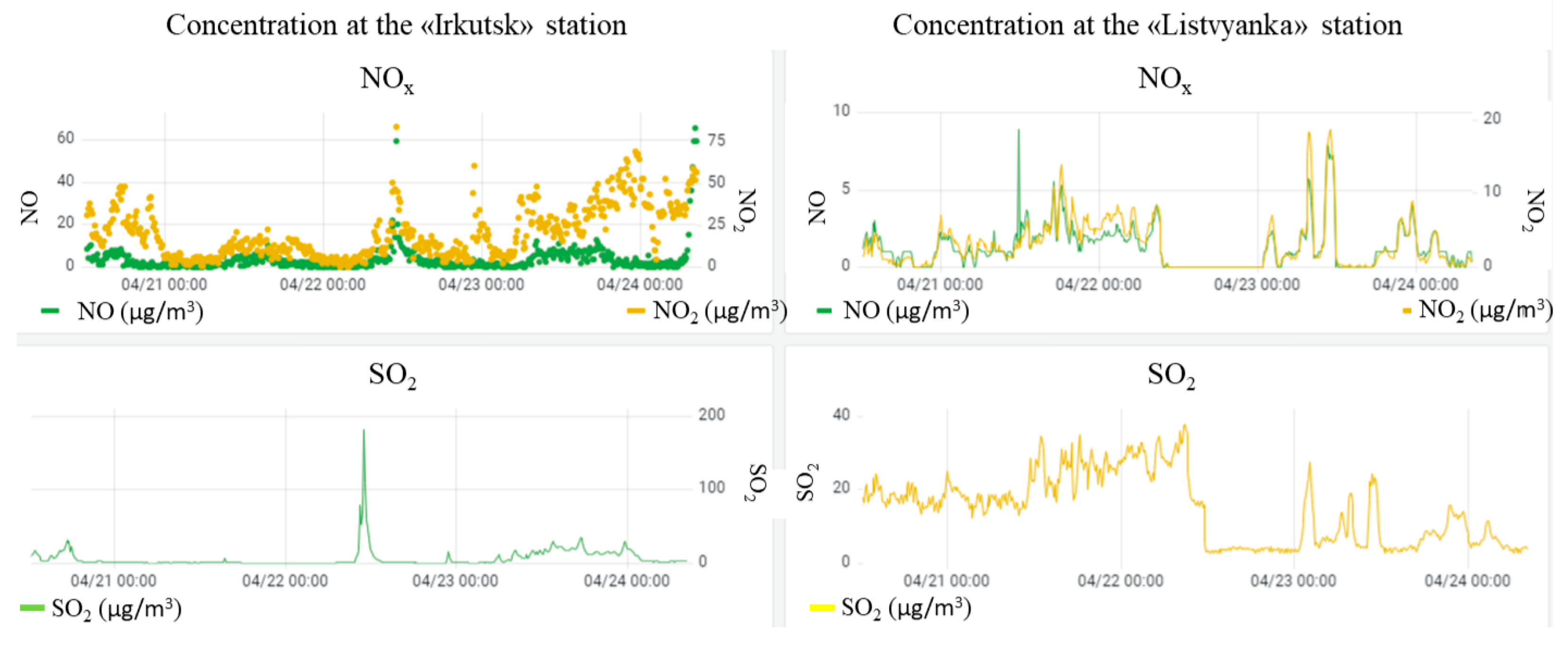

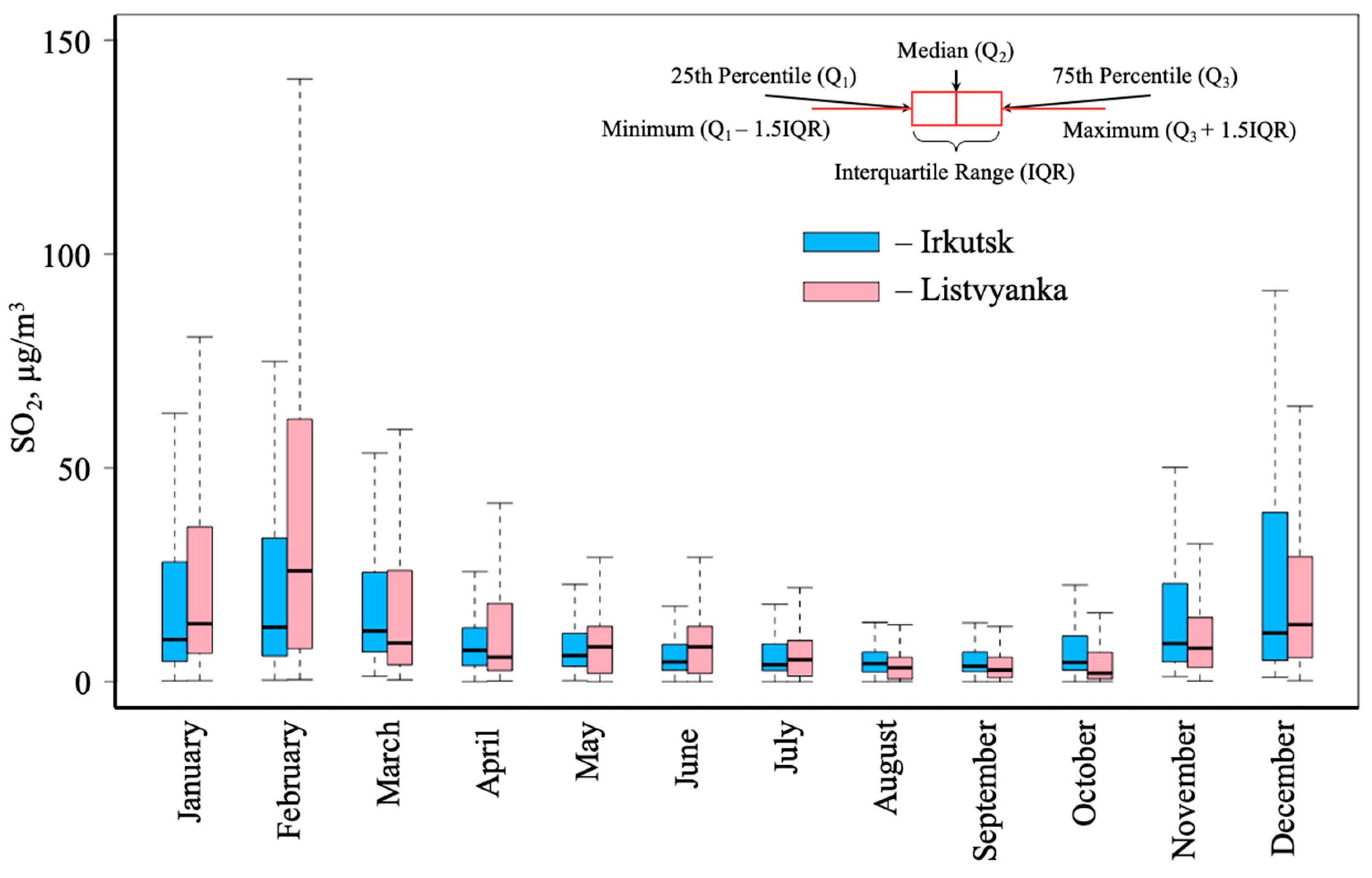
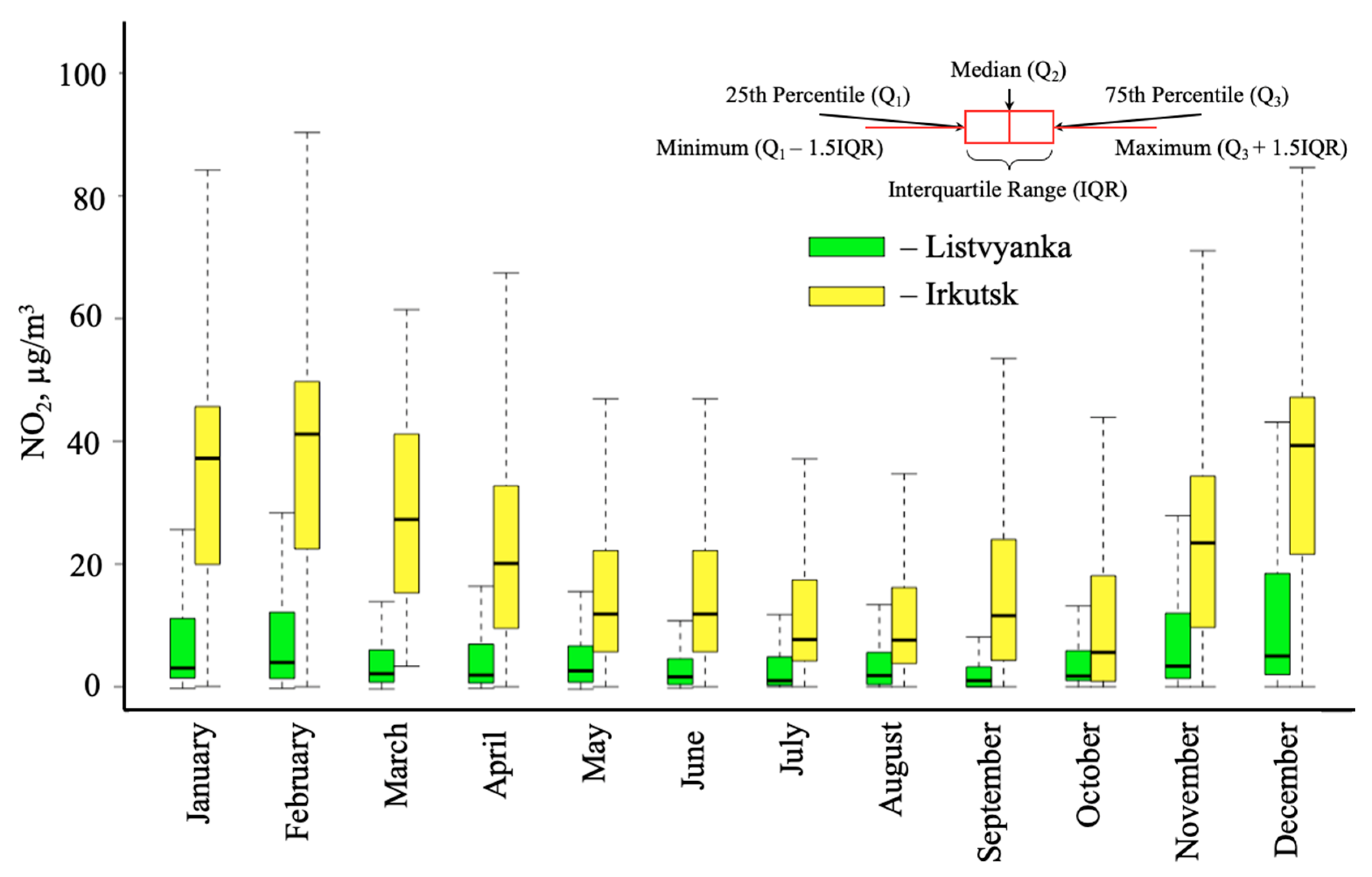
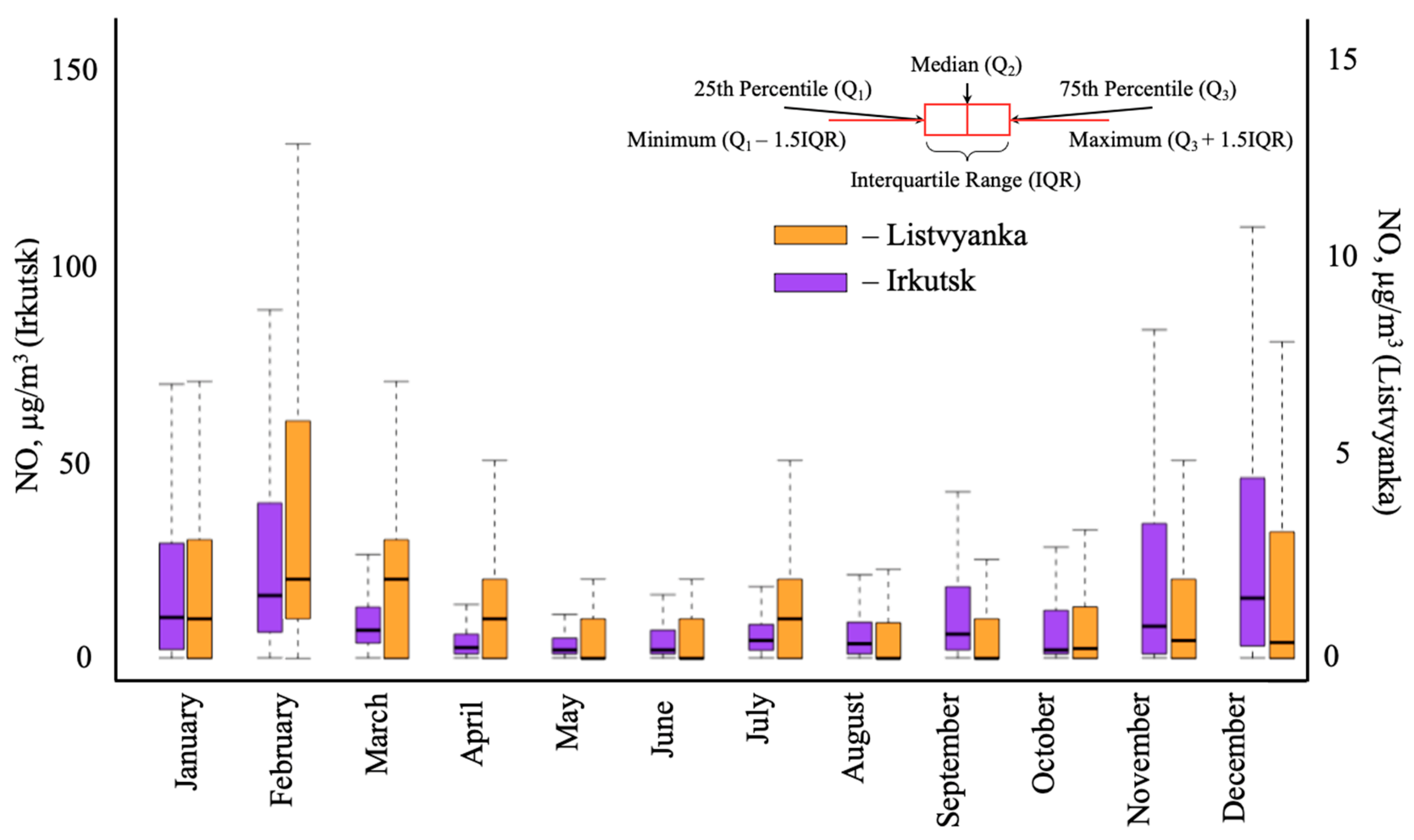

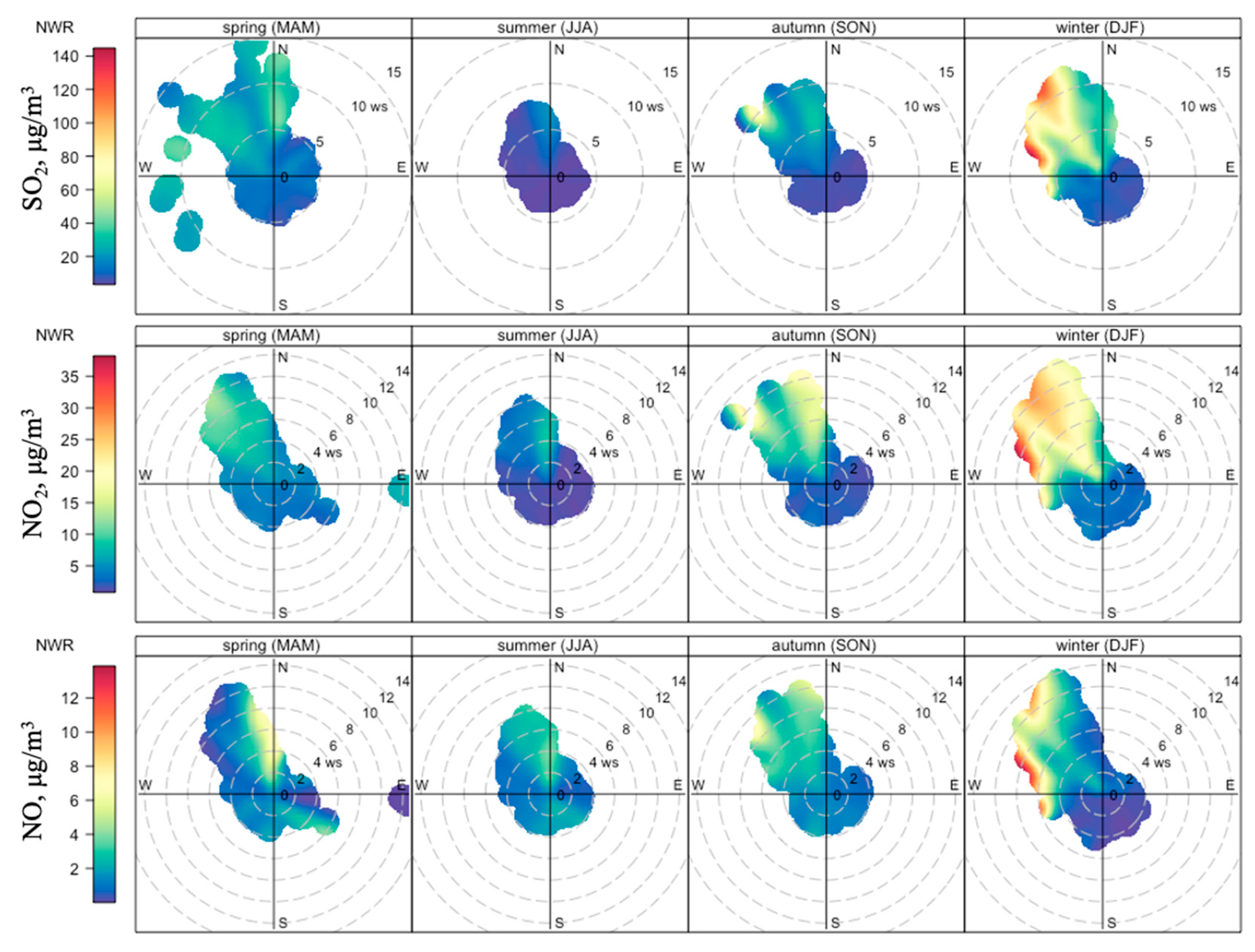
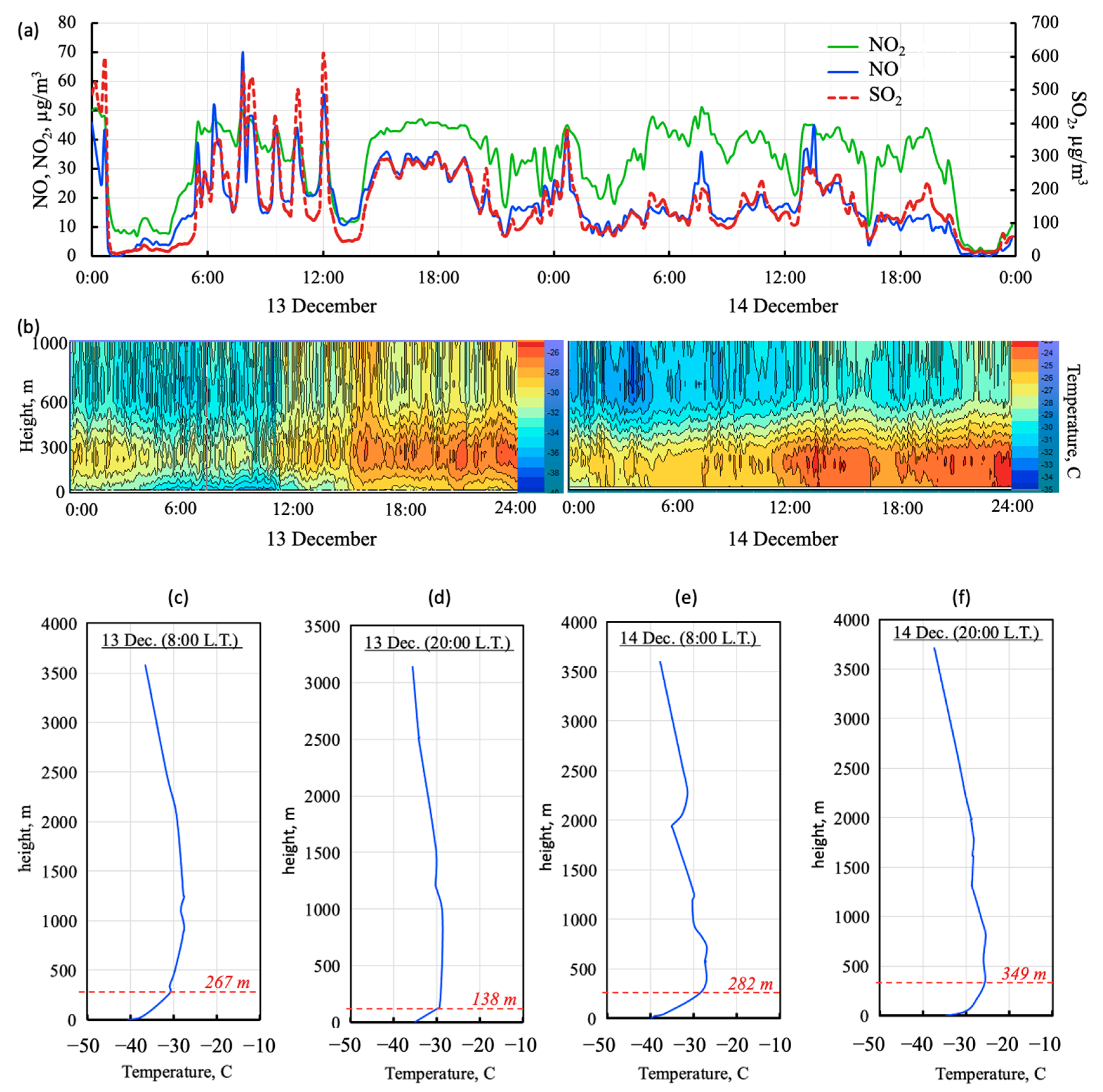

| µg m3 | “Irkutsk” Station (Urban) | “Listvyanka” Station (Rural) | ||||
|---|---|---|---|---|---|---|
| Avg. Time = 20 min | SO2 | NO | NO2 | SO2 | NO | NO2 |
| Average | 7.0–19.8 12.2 | 7.8–19.3 13.6 | 14.9–28.3 21.6 | 7.2–22.1 16.4 | 1.4–1.3 1.3 | 3.3–8.1 5.7 |
| Maximum | 224.6–237.7 | 206.0–503.0 | 114.3–150.4 | 289–754 | 34–82 | 94.4–94.8 |
| SD | 10.1–25.8 19.3 | 12.6–32.6 26.5 | 14.5–20.8 19.4 | 9.0–37.8 23.4 | 2.6–3.8 3.2 | 4.8–11.1 8.0 |
| Median | 4.5–9.0 5.7 | 3.6–7.0 5.3 | 10.1–26.7 17.1 | 4.5–9.2 6.8 | 0.0–0.0 0.0 | 1.4–3.0 2.2 |
| Avg. Time = 1 h | I | II | III | IV | V | VI | VII | VIII | IX | X | XI | XII |
|---|---|---|---|---|---|---|---|---|---|---|---|---|
| SO2 > 85 µg m3 | 219 | 205 | 68 | 1 | 8 | 0 | 0 | 0 | 2 | 16 | 67 | 238 |
| n | 2924 | 2329 | 2519 | 2097 | 2152 | 2329 | 2030 | 1952 | 2093 | 2089 | 2341 | 2777 |
| NO2 > 35 µg m3 | 209 | 180 | 33 | 7 | 5 | 2 | 1 | 45 | 6 | 48 | 158 | 260 |
| n | 2787 | 2119 | 2129 | 1959 | 2146 | 1927 | 1781 | 2680 | 2234 | 2564 | 2401 | 2669 |
| Month | I | II | III | IV | V | VI | VII | VIII | IX | X | XI | XII |
|---|---|---|---|---|---|---|---|---|---|---|---|---|
| Listvyanka station (rural) | ||||||||||||
| T, °C | −14.4 | −15.1 | −6.9 | 1.0 | 7.0 | 10.6 | 13.5 | 13.1 | 8.2 | 2.5 | −4.8 | −11.7 |
| Precipitation amount, mm/month | 18.3 | 8.4 | 7.6 | 16.0 | 59.3 | 76.4 | 122.2 | 77.2 | 46.0 | 22.3 | 14.2 | 19.1 |
| Mean wind speed, m/s | 3.2 | 3.8 | 3.5 | 3.4 | 3.3 | 2.8 | 2.6 | 2.3 | 3.0 | 3.3 | 3.7 | 4.3 |
| Irkutsk station (urban) | ||||||||||||
| T, °C | −16.2 | −14.8 | −4.9 | 3.8 | 11.0 | 16.4 | 18.3 | 16.0 | 9.4 | 2.5 | −6.2 | −14.4 |
| Precipitation amount, mm/month | 27.3 | 14.3 | 6.1 | 14.6 | 47.2 | 88.9 | 129.9 | 67.5 | 43.1 | 15.5 | 18.2 | 19.6 |
| Mean wind speed, m/s | 1.6 | 1.7 | 2.0 | 2.0 | 2.0 | 1.6 | 1.5 | 1.4 | 1.7 | 1.8 | 1.7 | 1.4 |
Disclaimer/Publisher’s Note: The statements, opinions and data contained in all publications are solely those of the individual author(s) and contributor(s) and not of MDPI and/or the editor(s). MDPI and/or the editor(s) disclaim responsibility for any injury to people or property resulting from any ideas, methods, instructions or products referred to in the content. |
© 2024 by the authors. Licensee MDPI, Basel, Switzerland. This article is an open access article distributed under the terms and conditions of the Creative Commons Attribution (CC BY) license (https://creativecommons.org/licenses/by/4.0/).
Share and Cite
Shikhovtsev, M.Y.; Molozhnikova, Y.V.; Obolkin, V.A.; Potemkin, V.L.; Lutskin, E.S.; Khodzher, T.V. Features of Temporal Variability of the Concentrations of Gaseous Trace Pollutants in the Air of the Urban and Rural Areas in the Southern Baikal Region (East Siberia, Russia). Appl. Sci. 2024, 14, 8327. https://doi.org/10.3390/app14188327
Shikhovtsev MY, Molozhnikova YV, Obolkin VA, Potemkin VL, Lutskin ES, Khodzher TV. Features of Temporal Variability of the Concentrations of Gaseous Trace Pollutants in the Air of the Urban and Rural Areas in the Southern Baikal Region (East Siberia, Russia). Applied Sciences. 2024; 14(18):8327. https://doi.org/10.3390/app14188327
Chicago/Turabian StyleShikhovtsev, Maxim Y., Yelena V. Molozhnikova, Vladimir A. Obolkin, Vladimir L. Potemkin, Evgeni S. Lutskin, and Tamara V. Khodzher. 2024. "Features of Temporal Variability of the Concentrations of Gaseous Trace Pollutants in the Air of the Urban and Rural Areas in the Southern Baikal Region (East Siberia, Russia)" Applied Sciences 14, no. 18: 8327. https://doi.org/10.3390/app14188327







